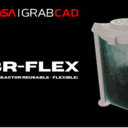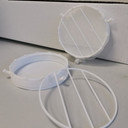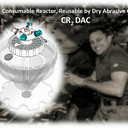

Design received overall highest marks for proposing a highly feasible, highly manufacturable design that proposed use of a single material that is both readily recyclable and bio manufacturable, having taken into account fluid behaviors in microgravity, modeled fluid interactions and presented convincing data of culture interaction with gas exchange membrane, referenced a convincing 3D printable gas permeable membrane of same material, was simple in design, requiring no moving parts and assembled from only two pieces, one of which could be reused to limit need for re-printing, allowed for future sensor additions, considered both aerobic and anaerobic growth conditions and that included design for grouping multiple bioreactors and could accommodate many types of organisms.

This design was considered low risk with regards to stirring and mixing efficiency, manufacturability and proposed good use of established food-grade material with good temperature tolerances. There were minor concerns with air inlets and sealing feasibility, and some uncertainty about the gas management but it was an innovative design solution to have the offset rotary vane system. Overall this type of large surface area to volume design has proven successful in gas management and this design was rated as feasible and overall likely successful.

This design was rated as highly novel for a 3D printed bioreactor. The report included technical details on design trade-offs and options as well as excellent bioreactor simulations performed under different conditions followed by proof-of-concept experiments to demonstrate feasibility. Design included clever solutions to printing a thin film for a flexible bag design, and addressed risks including striations in 3D printing and mitigations/approaches to buy-down risk.

This design included very clever geometry assists in mixing and delivery of gas and nutrients. There was in-depth consideration of capillary forces in microgravity, with flow simulations effectively modeling the design. There were some concerns about cleaning methods and the relatively higher complexity and difficulty to 3D print the finer design details that make this a slightly riskier design solution.

This design was awarded due to its simplicity and scalability. Judges were impressed with the customizable design to allow for meeting volume and gas exchange requirements. Process for recycling/reuse was well thought out and presented.

This design incorporated a truly innovative wick design and sensor ports to increase experiment utility. This proposal was noted for having great CAD work and overall thoughtful approach. There were some concerns about the complexity of the design and with use of magnets in the flight design.

There were several designs that were based off the coffee cup design and took into account fluid behaviors in microgravity. This design was given honorable mention as the best “coffee cup” design for its smart utilization of a microgravity-proven design.

The judges truly valued the many designs that addressed the gas permeable membrane issues. This proposal had a well-documented and novel membrane approach that included CO2 capture and was worthy of an honorable mention.

We want to express our appreciation for all the contestants that put in the extra effort of printing their designs. A few contestants even leak tested or otherwise demonstrated the printed and assembled designs. Competition was stiff, but this design was chosen as the best printed and demonstrated and worthy of an honorable mention.

This design was to be built on the ground, and not in space, to be a more cost-effective approach and it was perhaps the most novel. Its approach required an abrasive cleaning method that if successful could be revolutionary, but lack of prior data on whether this would be sterile and reusable, as well as concerns of PTFE waste and particulate generation lowered its ranking. Both judges and community members found this to be a truly thought provoking proposal.


If you don't receive the email within an hour (and you've checked your Spam folder), email us as confirmation@grabcad.com